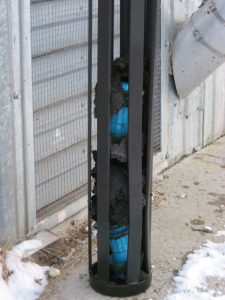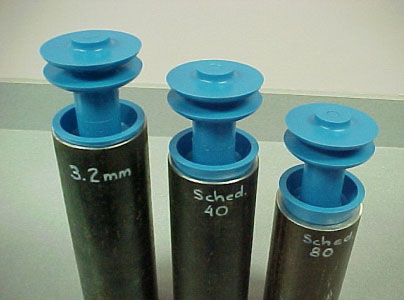Sphere or ball type pigs and foam pigs are commonly used in pigging of production flow lines – but the effectiveness of sphere or foam pigs is not often considered.
Sphere / Ball Type Pigs
A sphere pig has no aggressive cleaning ability and in fact is a displacement pig. Displacement pigs, if properly sized, can be effective in removing liquids and very loose debris.
However most spheres are too small in diameter for typical thin wall buried line pipe. A sphere has a very strong geometric shape, and usually being solid elastomer, does not squeeze down easily to smaller ID’s. Therefore spheres are typically sized for the smaller ID of the heavier wall risers and above ground piping. This is to allow for reasonable ease in inserting the ball into launchers and to be able to launch it with manageable differential pressures.
When a sphere is sized to easily insert into the above ground piping it is usually smaller than the below ground line pipe. The lack of interference fit and lack of aggressive scraping edges makes them inefficient.

In waxy oil production systems a sphere can provide a pipeline opening close to the sphere’s diameter in the wax. This would be a marked improvement in flow efficiency over a non-pigged line but obviously not optimum. More importantly a sphere and especially an undersized sphere cannot clean the line to bare steel required for corrosion inhibitors because it has no scraping ability.
In corrosive gas systems, an undersized sphere will have little to no effect in preventing corrosion. It has a limited ability to move larger slugs of liquids but will still leave much behind.
Foam Wire Brush / Foam Coated Pigs
Foam pigs are able to squeeze through large restrictions and therefore are not very aggressive, as they will often squeeze over what they are to remove. If there is enough resistance from a large quantity of deposit or large static head of liquid, the pig will squeeze past or be torn apart. It is not unusual to see parts and pieces of foam pigs left in the line or they can get into downstream facilities where a pig should not go. Economics can be misleading as foam pigs have a very short life span compared to urethane pigs due to the nature their construction. You should consider the cost of ownership vs. the cost of the pig. If a Cup/Disc style pig costs twice as much as a foam pig but out lasts it 5, 10, 20 times then the foam is not the cheaper alternative.
Harder density foam pigs are available but do not increase the life to that of a urethane scraper pig. Brush type foam pigs are available. The foam brush pig is constructed the same as conventional foam pigs with wire strips wound in a spiral fashion around the body. The bristle strips stiffen the foam brush pig considerably, so they do not flex easily for changes in system ID.
If a system contains solids or scale, a sphere or foam pig will not be effective in removing the solids for proper inhibitor treatment or control bacteria colony growth.

Aggressive Pig Design
Contemporary production systems are commonly built to CSA standards using high yield strength thin wall buried line pipe. Above ground piping is usually built to ANSI codes and of heavier wall pipe and fittings. As an example, typical 3”, 3.2 mm or .125” wall thickness line pipe has an ID of 3.25”. Riser pipe in schedule 40 has an ID of 3.068” and schedule 80, which is not uncommon, has an ID of 2.90”. The change in ID from line pipe to schedule 40 is ~7% and ~11% compared to schedule 80.
An effective scraping pig must have enough interference fit to be able to seal and scrape in the buried line pipe but pass through the risers.
The pig should be sized to be 4% to 5% larger than the line pipe so the oversize compared to the risers is even more. A 3” pig would be 3.40” in diameter for 3.2 mm or .125” wall thickness line pipe. This would make the pig ~11% larger than schedule 40 risers and ~17% larger than schedule 80.

Pig design is obviously important in order for the pig to be able to pass through the risers and still be effective in the larger ID line pipe.
Pig diameter versus line pipe ID is often missed when pigs are purchased. A pig that is undersized has some misinterpreted advantages. It rarely hangs up and never seems to wear out. Production systems were intended to transport liquids or gases, not solid objects, so you must expect there will be pressure increases and potential for hang-up when running a properly sized pig. If the pig does not wear it cannot be doing any work. A worn out pig is no more effective than an improperly sized pig.
A pig must be able to seal and scrape in the ID of the buried line pipe, but be of a design that allows the pig to flex though heavy wall above ground piping and pass through 1.5-D 90° elbows without severe distortion and by-pass. If brushes are used, they should be able to be effective in scraping the buried pipe but flexible enough to pass through the above ground piping. Stainless steel brushes are recommended to reduce bristle failure. Bristles can be lost from stress corrosion cracking, and end up in valve seats and orifices where they can create other problems.

